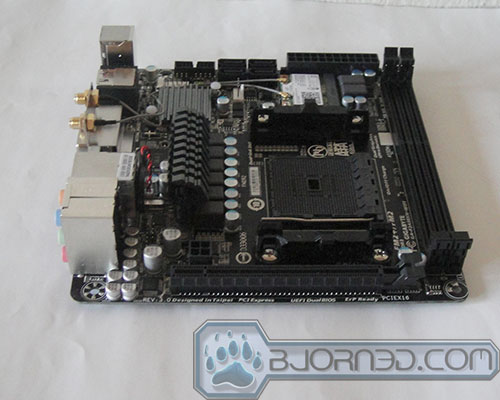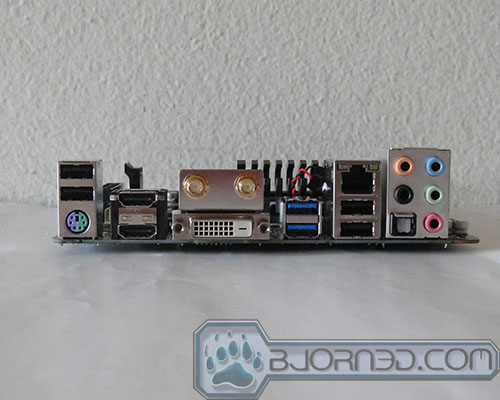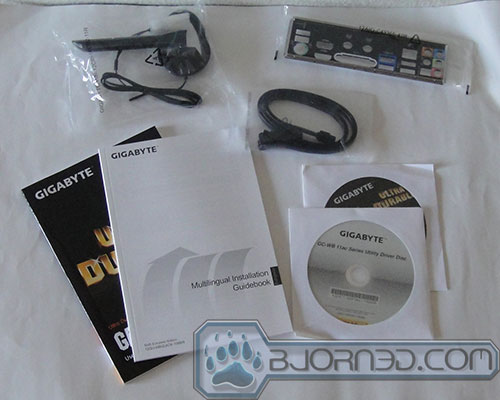Gigabyte’s F2A85XN-WIFI was one of the best mini-ITX board for the FM2 socket. With the release of the Kaveri (FM2+) APU, Gigabyte has updated their mini-ITX board with the latest A88X chipset. With the F2A88XN-WIFI, Gigabyte essentially retained the same overall design and the layout as the older board except it has swapped out the FM2 socket for the FM2+ so it will support AMD Kaveri and it has added support for 802.11ac. So if you are aiming to build a mini-ITX system with the latest AMD APU, you would probably want to check out this review for more information as to what the board has to offer.
Board Layout
Visually, it would be hard to tell F2A88XN-WIFI apart from its younger sibling F2A85XN-WIFI as both boards sports exactly same layout to a T. If it were not for the different color CPU socket (black for the A88X and white for the A85X), it would be impossible to tell the two boards apart without looking at the label on the motherboard. What this means that whatever issue that is inherited from the A85X will also appear on the A88X. At the same time, this also means that if you already have a system with the A85X board and are considering upgrading to the A88X for the Kaveri, then you should not have any issue just swap the boards out without having to worry about clearance.
Generally speaking, the A88X has no major issue with its board design. Packing various ports and components to a 17 cm x 17 cm is not an easy task. Gigabyte manages to pack the board with a full size PCIE slot for expansion, four SATA ports, two full desktop DDR3 DIMM slot, and a wireless card. It even packed with internal header for the SPDIF, USB 2.0, AND USB 3.0 header and two fan headers.
Low profile heatsink for the PWM and the Southbridge are used to help with the overall space imitation. Powered with 6 phase power for the CPU and two additional phase for the RAM, the board features the Ultra Durable 4 Plus technology where all solid capacitors are used with Low RDS MOSFETs which are rated to work at higher temperatures to provide a longer lifespan. It also features Ultra Safe dual UEFI BIOS, high ESD protection for the USB 3.0 and LAN port and single fuse for each of the USB 3.0 port.
Take a closer look at the CPU socket, we can see that Gigabyte moved the CPU socket a little bit south of the board and put all of headers and the ports on the northern end of the board. The chipset has also been moved from its usual place of the left of the CPU to the upper right hand. The rearrangement of the internal components means that the CPU socket is essentially sits near the center of the board. So if you are using a relatively large horizontal mount heatsink, it will inevitably hovers above the internal ports. Not only that , any heatsink wider than the heatsink retention bracket will also block the PCIE slot. Vertical cooler probably would fare better. If would obviously be better to pick one of the small form factor heatsink like the Noctua NH9a or stay with a cooler that is no larger than the width of the CPU retention bracket if you are looking for a larger unit for slight over clocking. The board uses 4 pin ATX auxiliary power connector as oppose to the typical 8 pin that is found on the ATX board. This is probably done due to space constrain. It is unlikely that anyone who is building the mini-ITX system would win the over clocking record so the fact that it uses 4 pin additional power should not pose much issue. Unfortunately, its location is a very awkwardly placed between the CPU and the PCIE slot, just behind the PWM heatsink. If you already have the graphic card installed, getting to this port would be rather hassle.
Behind the PWM heatsink is where we will find a 4 pin fan header that is in addition to the main CPU heatsink fan header. Here is where we can also find the CMOS battery taped to the rear IO port. Whereas oppose to the standard battery clip, Gigabyte uses a header to connect to the motherboard which would make it a bit harder to replace. Two DDR3 DIMM slots are located just next to the CPU socket. They are placed very close to the edge of the board. They will support 1.5V DDR3 modules at speed of 2400(OC)/2133/1866/1600/1333 MHz. AMD Memory Profile (AMP) / Extreme Memory Profile (XMP) memory modules are supported so that you would not need to mess around with individual setting if you purchase one of these memory modules. To the right of the CPU is where the single PCIE x16 slot is located. The slot is capable of supporting PCIE 3.0 up to x16 bandwidth. To get such speed, you would need to pair the board with a Kaveri APU. As mentioned all of the ports are essentially located on the upper edge of the board.
Starting from the right, we see the main ATX 24-pin power connector. Next to it is the four SATA ports, followed by an internal USB 3.0 header. Just below the USB 3.0 header is where we will find the internal USB 2.0 header and the front panel header. Right under the USB headers is where the A88X chipset is located, just behind the rear IO ports. A small low profile heatsink sits above the chip that is small and short enough that it won’t pose any clearance issue. All together (both internal and external), the board comes with four USB 3.0 ports (two on the rear and two via the front header), six USB 2.0 ports (four on the rear and two via the header), and four SATA 6Gbps ports which is sufficient for average users. The A88X chipset on the board is essentially the same as the A85X with the same number of IO ports supported. All connectors and ports (USB, SATA, PS/2) are being handled by the A88X chipset, we do not find many additional chips on the board except the SuperIO and the audio chip.
The AMD A88X chipset supports up to six SATA 6 Gbps with RAID 0, RAID 1, RAID 5, RAID 10, and JBOD but due to space limitation, we only get four on the board. Unfortunately though, Gigabyte did not route one the two remaining SATA ports to the rear panel for eSATA. The AMD A88X chipset not only handles the necessary IO but also features AMD Dual Graphics technology where you can add another graphic card to work in conjunction to the integrated GPU for additional monitor support or extra performance. Right below the SATA ports are the two BIOSes and next to it is the CPU fan header and the clear CMOS header. The DualBIOS is an unique feature that we often find on high-end motherboards where two BIOSes are located on the board to provide a back up in the event the primary one is corrupted due to overclocking or inappropriate flashing. We are glad to see Gigabyte retained such feature on the board though the secondary BIOS on the board only provides a backup for recovery and will not let you save different profiles or experimenting with over-clocking settings like what we have seen with some other Dual BIOS motherboards. While its feature is a bit limited, it’s a nonetheless good to have a backup system in the event of a corrupted BIOS.
Moving down from the A88X chipset is where we will find the add-on mini-PCIe WiFi and Bluetooth module. It hops along the PCI Express 2.0 lanes on the A88X chipset to provide the wireless connectivity. With the A88X, Gigabyte has swapped the ATHEROS AR5B22 PCI-E wirelss 802.11 b/g/n + BLUETOOTH 4.0 card on the A85X with the Intel AC 7260 PCI-E. This is a welcoming change as it brings support for 802.11 ac in addition to the b/g/n support which bump the maximum throughput from 300 Mbps to 867 Mbps. Like the older board, the Intel version also supports dual band for speed up to 867 Mbps and Bluetooth 4.0 with low energy support as well as 3.0+HS ad 2.1+EDR. In addition, the new wireless chip adds support for Intel WiDi so you would be able to stream contents directly to your HDTV wireless. The Bluetooth 4.0 also supports Smart Ready Technology.
The external antenna that Gigabyte has included with the wireless card remained the same where it offers 180 degree adjustment where you can improve signal quality by adjusting the antennae left or right.
Flip to the rear we once again find the same ports as the A85X. Here we have a PS/2 keyboard and mouse combo port, four USB 2.0 ports, a dual-link DVI-D port, two HDMI ports, two USB 3.0 ports, antennae connectors, one Gigabit ethernet port, one optical SPDIF connector, audio port. AMD Kaveri will support up to three displays and also supports 4K resolution via DiaplayPort and HDMI port. It is interesting that Gigabyte chooses to include two HDMI ports as oppose to have DisplayPort for one of the HMDI port. We rather prefer to see DisplayPort for future-proof and wider compatibility since there are some cheaper 4K displays that may only come with a single DisplayPort. The audio on the board is being handled by the Realtek ALC892 and the Gigabit Ethernet is handled by the Realtek as well.
The board is shipped with the driver disc, manual, an installation guide, two SATA cables, the backplate, and a case sticker. All the essentials are here to get your system up and running. We do think a couple of extra SATA cable would be nice as many of us probably have more than two drives inside our PC.
Software Bundles
Gigabyte bundles the GA-F2A88XN-WIFI with the typical array of drivers that includes AMD Chipset driver 12.105.0.0, Realtek HD audio R2.7, Realtek 8111/8168 LAN driver, AMD AHCI Driver 1.3.001.0068, ON/OFF Charge. In addition, it also includes Gigabyte’s in house and other utilities such as Easy Tune 6, @BIOS, Smart Recovery 2, DMI Viewer, Face-wizard, Update Manager, Auto Green, Realtek Ethernet Diagnostic Utility, LanOptimizer, AMD GAME!, AMD LIVE!, and Gigabyte 3TB Utility. Furthermore, other included software are Chrome browser, Google Toolbar for IE, Google Drive, Norton Internet Security 2013 60 days trial, and a list of Cyberlink software that includes PowerDVD 12, PowerDirector 11, Power2Go 8, PhotoDirector 4, YouCam 5, and MediaExpresso 6.7. The Cyberlink software titles are not included but rather they will direct to the Cyberlink’s website to download the trial version of the software.
The EasyTune 6 is Gigabyte’s own system monitoring and overclocking tool. It has not changed much since we first saw it a few years back. While the interface is easy to navigate, it feels rather outdated. It does get the job done and its small footprint is something worth mentioning that is not as bloated as the Asus AI Suite. Anyone who had one of the Gigabyte’s board over the last couple of years should feel at home with the EasyTune and have no trouble setting it up. No new features has been added with the latest revision as it still provides you with limited over clocking ability. In addition, it provides the ability to fine-tuning the fan speed. The @BIOS provides the ability to update BIOS through internet and the Smart Recovery 2 is based on the Windows 7 Shadow Copy Service technology that provides system backup. The DMI viewer provides motherboard hardware information, the Face Wizard provides customizing BIOS boot up screen, the Update Manager lets you automatic update Gigabyte’s software by the Internet, and the Auto Green works with Bluetooth device where if a device is out of the range after a certain period of time, the hard drive will turn off to save power.
A few special tool included with the board is the WiFi Share that is also present with the older boards with wireless connectivity where it lets you share files and folders with other devices over the wireless network. The good thing about this is that it will work with any wireless adapters and motherboards so you are not limited to just Gigabyte products. You are able to share files across different PCs and laptops. All you have to do is install the software on both devices and enable the features to get ready to share files across both devices.
The GIGABYTE Cloud Station utility helps GIGABYTE Apps (and future GIGABYTE Apps) to communicate, share resources and control desktop PC systems. The Apps interact with the PC via Bluetooth, WiFi, or USB. It was initially only for iOS devices but Gigabyte has updated it so that it will also work with Android devices. It seems like this would be the future of Gigabyte’s mobile App much like the Easy Tune for the desktop where it will be the centralized software to interact with your PC. To use it, you just need to grab the App from the Google Play store or iTune store and have a system with Windows 7/8. We downloaded the Android version onto our Note II running Android 4.3. Upon starting the App, we were asked to log-in with gmail account, Facebook, or your phone number. Afterwards, the App will scan for available system to sync. Unfortunately, we were not able to get the App to connect to our system so we cannot test the App out. From what we can tell, the Apps seems to provide some nice tools such as remote control, home cloud to share and upload contents between the mopbile device and the PC, and remote over clocking At its current state, the Apps still need a bit more work to get all of the kinks worked out then it would be a handy tool to have.
Review Overview
Performance - 8.5
Value - 9.5
Quality - 9
Features - 9
Innovation - 8
8.8
Gigabyte F2A88X-WIFI
For mini-ITX FM2+ motherboard, the F2A88XN-WIFI is packed with plenty of features that includes four SATA ports, 802.11ac, dual BIOS, and dual HDMI port. We definitely recommend anyone who is looking to build a small form factor PC with AMD Kaveri APU.
 Bjorn3D.com Bjorn3d.com – Satisfying Your Daily Tech Cravings Since 1996
Bjorn3D.com Bjorn3d.com – Satisfying Your Daily Tech Cravings Since 1996




























You mention WIDI support but how do I go about actually enabling this feature?
the wireless adapter (Intel 7260) does support WiDi though to use WiDi, you would need also Intel CPU. AMD has their own Wireless Display where it is based on Miracast. If you are using Winodws 8.1, it should work. Though we have not yet test it.
http://community.amd.com/community/amd-blogs/amd/blog/2013/09/12/a-preview-of-amd-wireless-display-in-windows-81